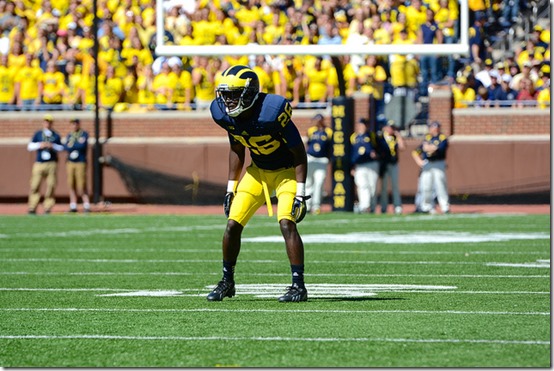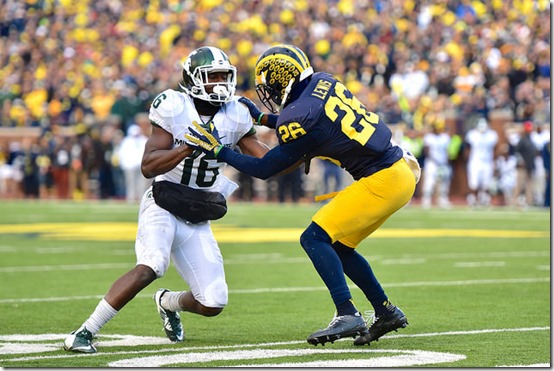press coverage
[Fuller]
Last week when we talked to you, you said one of the things you were working on was getting your head around at the right time. From a technique perspective, when is the right time to get your head around?
“When you’ve got a receiver under control. When you understand that he’s not doing any other route except for a fade, and that’s just going off your instincts, too. Just knowing that, okay, I feel like it’s time to turn my head around. Just being in phase, being in the hip, and going up and being a playmaker.”
So part of that is just experience?
“Yeah, and watching film. Honestly, that helps a lot, just seeing if they like back-shoulders or if they just like the normal fade, stuff like that. So just going up there and understanding what formations those guys like to do that and when they like to do it.”
One question I have is about off coverage. I know you play press man most of the time, but from a fundamental perspective, in off coverage what’s the most important thing? When I was talking to Coach Zordich earlier in the year he said in press you look at the belt buckle, then--
“It’s still the eyes. Your eyes are the most important thing in football, and just to watch the waist because the waist doesn’t really move. It’s understanding where your end points are and your keys and stuff like that and just knowing what to do. Just watching him and then using your tools to succeed.”
Is the corner’s first step more important in press or in off?
“The first step? In press, honestly. When you talk about the first step, if you misplace your steps in press that’s the difference between a breakup and a catch. In off coverage, I believe that it can be the same thing, honestly, but it’s more critical in press.”
Hawaii has one receiver who’s 6’5 and some receivers who are 5’10. I know you can’t say who you’re going to be matched up on, but in general when you have some guys who are really tall and some who are shorter, does your technique change at all?
“It could. You could be a little bit overaggressive with the bigger guys because they have a lot more surface to put your hands on and then a lot of times they’ll be a little bit slower than the little guys. A smaller guy, you’ve just got to be patient and move your feet and stuff like that. Yeah, you have to gameplan and understand who you’re checking.”
With some of the younger guys on the roster, guys like David Long and Lavert Hill, what’s impressed you most about where they’ve come from the beginning of camp until now?
“The way they learn, honestly, and just how fast they learn and have picked up the playbook, and that’s really what it is. I think that’s helped both of them.”
What about other guys in the corner group like Stribling and Jeremy Clark?
“Just experience, honestly. Having those guys play last year a whole bunch of snaps that really helps them, and just getting a feel going out there and playing.”
[Fuller/MGoBlog]
When I talked to Ryan Glasgow back in November after the Minnesota game, he said that he had kind of been able to pick up on how the offensive linemen were standing and pick up some tells whether the play would be a run or pass. When you’re lined up across from a receiver, are you able to pick anything up from them during a game or from watching film? Do they have certain tells?
“Yeah. It’s always about feeling the game and just knowing what they’re going to do. A team always has a gameplan coming into a game, so it’s a script and sometimes they go off the script and then they come back to the plays that they hit you on so you know. You have a feel for what they’re going to do next, so honestly it’s just feeling that, what your receiver likes to do, and just getting in that feel.”
Do they ever tip what route they’re going to run based on how they-
“Yeah. Linemen always tell. The formation is a big teller, and it’s just…yeah, it’s pretty much the feel, honestly.”
You’ve played a lot of man-press this year and you’ve talked a lot about technique, and I know your coaches say it all the time too, that the most important thing isn’t size or speed but is technique. Walk me through that; when you’re lined up in press, what are you looking to do as soon as the ball’s snapped?
“Be physical at the line of scrimmage. Disrupt them. Just do anything I can to bother them at the line. Just being in his hip pocket—you know, that annoys them, just knowing that you’re always there and they don’t have space to move and the quarterback has to put the ball on the spot, so honestly that contributes to incompletions and pass breakups and stuff like that because once you keep getting that tight coverage you know sometime that line’s going to break down.”
What if you have to take a guy a little bit deeper down the field? Say you’re 15 or 20 yards down the field. What’s the technique then?
“You’re trying to push them to the sideline. You’re trying to get them to the sideline, and then you’re trying to stay up under the route and get up in his back hip and turn around and try and look for the ball.”
[After THE JUMP: how to break up a pass and not get burned, a Florida scouting report, and a week of preparation]
I've written in various places, and Brian said again just yesterday, that Blake Countess is a very good zone cornerback who was exposed last year by being asked to do things outside of his comfort zone. Or outside his natural abilities. Or outside the capabilities of a guy his size.
The tape is the best evidence that he's not a fit for the aggressive man-to-man stuff Michigan switched to early last season, and will almost certainly try again this year. The best evidence against it was produced by Countess this spring, when he generated above the usual level of comments for controllable things like his work ethic, his knowledge of the defense, his toughness, etc.
But his size is a thing Blake can't change, and that plus the inability to shut down Tyler Lockett or William Fuller downgraded our hopes for a next-Woodson (leave him on an island) ceiling even before we discovered he's no MC5:
(you forgot to kick out the jams.)
That kind of thing can be mitigated by not lining him up so close—you give up that lock-down mentality for either soft coverage that lets the QB complete short stuff, or puts a safety over the top so Countess can break on that stuff.
Is Countess too small?
His size is below average for a guy who registered a play on a Power 5 roster, though not debilitatingly so. Here's how the CB depth chart stacks up against cornerbacks on all Power 5 rosters from 2010-2013 (#6 is Lyons):
Bubble size is more guys with that listed ht/wt. Avg height was 5'11", and weight was 183. Year-to-year differences were negligible.
If you need a roster refresher I put the tentative depth chart below-right. Our guys are generally on the line of distribution, with Richardson a wee little dude and Stribling and Dawson (and Keith Washington) on the edges of lankiness. I included Peppers to show just how different he is from most cornerbacks on this level of football, even as a redshirt freshman whose conditioning was hurt by a year of injury.
| No. | Name | Elig. | Ht. | Wgt. |
|---|---|---|---|---|
| 5 | Jabrill Peppers | Fr.* | 6'1 | 205 |
| 26 | Jourdan Lewis | Jr. | 5'10 | 176 |
| 2 | Blake Countess | Sr.* | 5'10 | 180 |
| 6 | Wayne Lyons | Sr.* | 5'11 | 190 |
| 8 | Channing Stribling | Jr. | 6'2 | 178 |
| 28 | Brandon Watson | Fr.* | 5'11 | 189 |
| 13 | Terry Richardson | Jr.* | 5'7 | 170 |
| 30 | Reon Dawson | So.* | 6'1 | 175 |
There were also quite a few teams who list all safeties and cornerbacks as "DBs"; indeed the cornerback sample we did get seems like it wouldn't change much. If you care here's Michigan's expected 2015 backfield rotation against the distribution of one year's Power 5 cornerbacks.
Interesting side-note: Florida's cornerbacks last year under Durkin were the smallest of any school in the Power 5. Using the formula from the chart above, Auburn and Minnesota were by far the biggest defensive backfields—both teams were about 6'0/200 with their cornerbacks. I know Minnesota at least is a man-all-day-long team. Nebraska and Ohio State were top five biggest, Iowa and Notre Dame around there and Stanford relatively big. Michigan was smallish—right around FSU and LSU. TCU was the second-smallest at CB.
Anyway Countess isn't the little guy according to the rosters; Lewis is. Jourdan's game is based on his recovery speed. He is just okay at jamming a guy at the line, but is so fast on a dead run and so quick to change direction that he doesn't have to stonewall his guy.
[Jump for what we've got in Lyons]






23